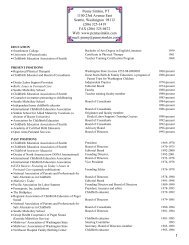The Win Win Birth Plan - Penny Simkin
The Win Win Birth Plan - Penny Simkin
The Win Win Birth Plan - Penny Simkin
You also want an ePaper? Increase the reach of your titles
YUMPU automatically turns print PDFs into web optimized ePapers that Google loves.
A <strong>Win</strong>-<strong>Win</strong> birth plan states the parents’ personal<br />
preferences but does not compromise quality of care. Its tone<br />
is respectful and flexible.<br />
Components of the <strong>Birth</strong> <strong>Plan</strong><br />
Your birth plan should contain an introduction, your<br />
most important issues, fears, or concerns; a general<br />
description of the approach to birth you prefer; and sections<br />
on normal labor and birth, care of the newborn, and<br />
unexpected events (a prolonged labor, cesarean birth, a<br />
premature or sick baby, even death of the baby).<br />
Your caregiver, your guide on the hospital tour, childbirth<br />
educator and your doula may be helpful resources as you<br />
prepare your birth plan, especially if they are familiar with<br />
the options available in your community. Use your childbirth<br />
educator or doula as a consultant on local practices, choices<br />
available, wording to use, or any aspect of the birth plan with<br />
which you need help. Your birth plan, however, should<br />
reflect your preferences and your partner's, and not those of<br />
your friends or advisors.<br />
<strong>The</strong> Introduction<br />
<strong>The</strong> introduction is a paragraph that tells the staff a little<br />
about your partner and yourself, why you chose your<br />
caregiver and place for birth, and explains why your birth<br />
plan is important to you. For example, you might want to tell<br />
the staff such things as: if your pregnancy has been pleasant<br />
and healthy; if you have had difficulties, such as infertility,<br />
previous miscarriage, emotional or physical problems during<br />
this or a previous pregnancy; if you have a fear of childbirth,<br />
hospitals, or medical procedures; if you have cultural or<br />
religious preferences or special needs; or if a natural or a<br />
medicated birth is extremely important to you. Also, provide<br />
helpful information about your partner or others who will be<br />
present. Who will accompany you? Do they have any<br />
physical or emotional problems that may influence their<br />
participation in your care? Will there be a unique<br />
combination of family members present (for example,<br />
adoptive parents, lesbian co-parents, children present), or<br />
stressful family dynamics? Are there people whom you do not<br />
want at the birth? Will you be accompanied by a doula? <strong>The</strong><br />
nurses can help you more effectively if they have this kind of<br />
information. You might also state that you will appreciate<br />
the expertise, help, and support of the staff in carrying out<br />
your birth plan.<br />
Important Issues, Fears and Concerns<br />
This paragraph is optional; you may have no particular<br />
fears or concerns, but if you do, this is your opportunity to<br />
My documents/admin/handouts/<strong>The</strong> <strong>Win</strong><strong>Win</strong> <strong>Birth</strong> <strong>Plan</strong><br />
<strong>The</strong> <strong>Win</strong>-<strong>Win</strong> <strong>Birth</strong> <strong>Plan</strong><br />
By <strong>Penny</strong> <strong>Simkin</strong>, P.T.<br />
disclose these to the staff and, if possible, why you have these<br />
concerns.<br />
For example, you may fear for your baby’s well-being; you<br />
may fear the hospital or its policies; you may be<br />
uncomfortable or distrustful of people whom you do not<br />
know who are in authority, such as nurses and doctors or<br />
midwives; you may worry about the pain of labor and how<br />
you may behave or cope; you may have issues with modesty;<br />
you may fear losing control; you may find vaginal exams,<br />
blood draws, or other procedures very stressful. Sometimes<br />
negative previous experiences play a role in these fears.<br />
Previous pregnancy losses or traumatic births, negative<br />
experiences with doctors or hospitals, growing up in a<br />
dysfunctional, abusive, or neglectful family—all these<br />
experiences and more may influence your feelings as you<br />
anticipate birth.<br />
By disclosing such feelings and some of the reasons, you<br />
can help the staff provide sensitive care and take your special<br />
needs into account.<br />
Normal Labor and <strong>Birth</strong><br />
When labor and birth proceed normally, few<br />
interventions are necessary for medical safety. Some<br />
interventions may be used, however, for other reasons.<br />
Sometimes, for example, caregivers induce labor or start<br />
giving intravenous fluids even when there is no problem, in<br />
the belief that it is better to use them before rather than after<br />
a problem arises. Other routine interventions, such as the<br />
back-lying position for birth, the use of stirrups, taking the<br />
baby from the mother for testing and observation, and<br />
changes of shifts of nurses and other staff, exist for the<br />
convenience of the staff or caregiver. Still others, such as<br />
antibiotics for the baby's eyes, newborn screening for PKU,<br />
hypothyroidism, and other conditions, are preventive and<br />
required by state or provincial governments. Some practices,<br />
such as enemas, shaving the perineum, and draping the<br />
mother’s body and legs during birth are less common today,<br />
but continue in some areas of North America. <strong>The</strong>y became<br />
routine at a time when they were believed to be beneficial,<br />
but now are known to be of little or no benefit or even<br />
harmful. Some routines, such as anesthesia and circumcision,<br />
may present an element of risk to mother or baby that may<br />
not be worth taking, depending on the beliefs of the parents<br />
and the benefits to be gained.<br />
Others, such as feeding sugar water or formula to the<br />
baby, began at a time when breastfeeding was discouraged<br />
and were believed essential to the baby’s well-being. Some<br />
procedures, such as epidural, cesarean, and circumcision,<br />
require your informed consent -- that is, only after your<br />
caregiver explains the procedure, its benefits and risks, and<br />
the risks and benefits of any alternatives (including not doing<br />
it) is your consent recorded in your chart.<br />
17
Part of your preparation will be to find out which<br />
routines you are likely to encounter, along with the reasoning<br />
behind them. Childbirth classes, the hospital tour, and your<br />
caregiver can help you find out which routines are used. As<br />
you prepare this part of your birth plan, mention only the<br />
preferences that matter to you. You do not have to hold an<br />
opinion on everything. Or, better yet, you might summarize<br />
your preferences with a blanket statement, such as, “I prefer<br />
to avoid routine interventions and procedures, and want to<br />
discuss any that are being considered.” Or, “I am comfortable<br />
relying on my caregiver to make decisions about<br />
interventions and procedures, and do not wish to be<br />
consulted.”<br />
Care of Your Newborn<br />
This section describes how you want your baby cared for<br />
during the first few days. <strong>The</strong>re are as many differences in the<br />
way healthy newborns are cared for as there are differences<br />
in every other aspect of maternity care. Generally, the healthy<br />
newborn needs little more than a warm environment,<br />
diapers, clothing, and access to her mother’s breast and<br />
parents’ arms. Particular observations, tests, and procedures<br />
are done routinely to discover serious congenital disorders or<br />
prevent potentially serious illnesses. In considering your<br />
options, balance concerns for your baby's comfort and wellbeing<br />
with the potential benefits and risks of each procedure.<br />
Unexpected Events<br />
<strong>The</strong> section on the unexpected will be most helpful if<br />
something unforeseen arises. A birth plan for a cesarean birth<br />
can help you retain some of the priorities of your original<br />
birth plan. Though an unexpected cesarean can be a<br />
disappointment, you will feel better about the experience if<br />
you have thought about this possibility, learn about your<br />
options, and express your preferences.<br />
Although almost all babies are born healthy, there is a<br />
slim possibility that something could go wrong or that your<br />
baby might have a problem. This possibility worries most<br />
expectant parents to some degree. You know that<br />
prematurity, illness, birth defects, or even death sometimes<br />
happens. It is helpful to consider in advance how you would<br />
want such misfortunes handled, because if they occur, many<br />
decisions have to be made when you are upset and unable to<br />
think clearly. Your birth plan can include such possibilities,<br />
so that the staff can care for you and your baby with<br />
knowledge of your preferences.<br />
Once you have made your birth plan for the unexpected,<br />
put it aside and concentrate on a normal birth and a healthy<br />
baby. You will probably not need the plan for the<br />
unexpected, but if you do, you will have your own plans to<br />
follow at this extremely difficult time. This will mean a lot to<br />
you later.<br />
Conclusion<br />
As you can see, preparing a birth plan requires time,<br />
thought, and information gathering. You should get input<br />
from your caregiver before you prepare the final version. By<br />
the time you have finished, you should have a fairly complete<br />
picture of what you can expect in terms of your care during<br />
childbirth and immediately afterwards. Not only have you<br />
and your caregivers formed a trusting relationship and made<br />
a general plan for managing your uncomplicated, normal<br />
labor and birth, you will also know how unexpected<br />
variations and complications are likely to be handled. This<br />
<strong>Win</strong>-<strong>Win</strong> <strong>Birth</strong> <strong>Plan</strong> helps lay the groundwork for a<br />
satisfying birth experience.<br />
My documents/admin/handouts/<strong>The</strong> <strong>Win</strong><strong>Win</strong> <strong>Birth</strong> <strong>Plan</strong> 17




